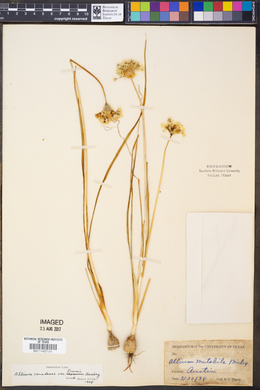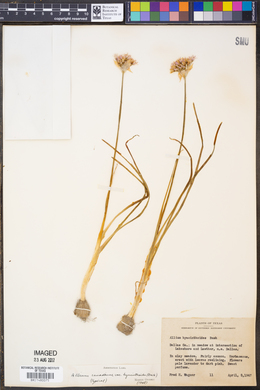Allium canadense
|
|
|
|
Family: Amaryllidaceae
Meadow Garlic, more...Meadow Onion
[Allium acetabulum (Raf.) Shinners, moreAllium continuum Small] |
Bulbs 1-4+, without rhizome, with or without basal bulbels, often clustered, ovoid, 1-2.5 × 0.6-3 cm; outer coats enclosing 1 or more bulbs, brownish or grayish, reticulate, cells fine-meshed, open, fibrous; inner coats whitish, cells vertically elongate, sometimes contorted, walls straight or ± sinuous. Leaves persistent, green at anthesis, 2-6, basally sheathing, sheaths extending less than 1/4 scape; blade solid, flat, channeled, not carinate, 20-50 cm × 1-7 mm, margins entire or denticulate, apex acute to obtuse. Scape persistent, usually solitary, erect, terete, 10-60 cm × 1-5 mm. Umbel persistent, erect, loose, 0-60-flowered, hemispheric to globose, bulbils unknown or flowering pedicels replaced at least in part by bulbils; spathe bracts persistent, 3-4, 3-7-veined, ovate to lanceolate, ± equal, apex acuminate, beakless. Flowers urceolate-campanulate, 4-8 mm; tepals erect or spreading, white to pink or lavender, lanceolate to elliptic, ± equal, withering in fruit and exposing capsule, midribs somewhat thickened, margins entire, apex obtuse to acute; stamens included; anthers yellow; pollen yellow; ovary, when present, crestless; style linear, ± equaling stamens; stigma capitate, unlobed or obscurely 3-lobed; pedicel 8-70 mm. Seed coat shining; cells each with minute, central papilla. see Allium canadense var. canadense for additional information. Perennial herb with one to four or more bulbs flowering stem 20 cm - 0.6 m tall Leaves: two to six, arising from lower half of stem, basally sheathing, 15 - 40 cm long, 2 - 7 mm wide, flat, grass-like. Inflorescence: an upright, dome-shaped umbel of zero to sixty flowers raised on a stout stalk and subtended by two to three bracts. Flowers sometimes growing with or replaced by egg-shaped, stalkless bulblets. Flowers: on long stalks, pink to white, 4 - 8 mm wide, bell- to star-shaped, with six tepals that wither when the plant is in fruit. Stamens six, upright. Fruit: a short, three-lobed capsule. Bulbs: often clustered, with or without basal bulbils (little bulbs), up to 3 cm tall, somewhat oval or egg-shaped, and encased in a brown, fibrous, netlike coating. Bulbs have a strong onion-like odor. Similar species: The fibrous netlike coating of the underground bulbs and the sometimes bulblet-producing umbel helps distinguish Allium canadense from other similar-looking Allium. Flowering: late April to early July Habitat and ecology: Common in mesic woods but may be found in a number of habitats. Occurence in the Chicago region: native Etymology: Allium comes from the Latin word for garlic. Canadense refers to Canada, but is also used in reference to North America (a result of early French influence). Author: The Morton Arboretum Bulb ovoid-conic, 1-3 cm, its coats fibrous-reticulate; stem erect, stout, 2-6 dm, leafy in the lower third; lvs elongate, flat, 2-4(-7) mm wide; bracts 2 or 3, broadly ovate, acuminate; fls when present pink or white, on pedicels 1-3 cm, often many or all of them replaced by sessile bulblets to 1 cm; tep withering in fr; fr not crested; seeds shining, finely alveolate, each alveolus with a minute central pustule; 2n=14, 21, 28. Open woods and prairies; N.B. to N.D., s. to Fla. and Tex. (A. mutabile) The common phase in our range is var. canadense, with many or all of the fls replaced by sessile bulblets, the fls, when developed, rarely producing fr. The strictly floriferous var. lavendulare (Bates) Ownbey & Aase occurs from Mo. to S.D., Okla., and n. Ark. Other floriferous vars. occur to the s. and w. Gleason, Henry A. & Cronquist, Arthur J. 1991. Manual of vascular plants of northeastern United States and adjacent Canada. lxxv + 910 pp. ©The New York Botanical Garden. All rights reserved. Used by permission. From Flora of Indiana (1940) by Charles C. Deam Found throughout the state. Frequent or common in the southwestern counties in moist soil in woodland and cultivated fields, where it sometimes becomes a pernicious weed. ...... Indiana Coefficient of Conservatism: C = 1 Wetland Indicator Status: FACU Diagnostic Traits: Leaves linear, <7mm wide, flattish, solid; sheaths short, leaves basically basal; beak of spathe <1.5 cm; umbels bearing bulblets. Indiana populations belong to var. canadense. |
|
|
|




































































































